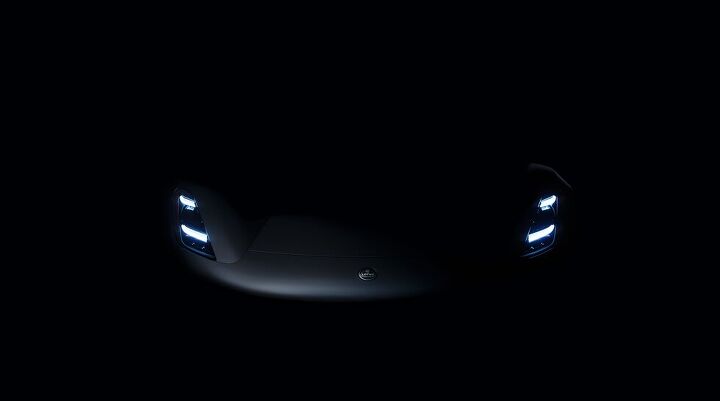Lotus Says Emira Will Be Its Last Gasoline Powered Model

Lotus Cars has announced that the Emira sports car will be its next and final internal combustion model as it prepares itself to become an exclusively electric brand. The historically British manufacturer says its Chinese owners, the Zhejiang Geely Holding Group, are preparing a cash injection of $2.8 billion to swap to EVs and expand its footprint.
While the present market makes those items feel as though they could conflict with each other, Lotus thinks that the climate will be different a few years from now and plans on going EV only by 2028. In the meantime, the Emira is scheduled to launch in July.
Base-model Emiras will come with a turbocharged 2.0-liter four-cylinder (likely sourced from Volvo/Geely) while higher end trims get the same supercharged Toyota V6 that’s in the Evora and costs substantially more. While the company hasn’t said how the vehicles will be priced, it did say to expect it to fall within the existing lineup.
This excludes the Evija EV that will be going into production later this year, which probably has many breathing a sigh of relief. The plug-in model will have a limited production run of 130 units and is supposed to retail at an estimated $2.3 million. Saying it’s something different for the brand is an understatement, though so is the Emira (bottom of the page).
Rather than shooting for the maximum amount of performance physics will allow, the coupe is focused on updating equipment and making Lotus products more livable. Ditching rollup windows, adding infotainment, and trying to mitigate NVH is likely to make the Emira pudgier than its soon-to-be-discontinued siblings. But we’ll have to wait to see if that makes the model less exciting to drive.
Regardless, this is to be the internal combustion engine’s last hurrah with the company. Lotus said that all subsequent products will be battery-electric only, without the need to soften the transition by building a decade of hybrids. Leadership has said that the firm might have clung to the idea of building vehicles designed almost entirely around driving excitement for too long, hurting its sales volume in the process. But the new solution seems almost as extreme and kind of makes the Lotus tradition of building featherweight cars impossible. Battery packs are extremely heavy, though engineers can use them to keep the center of mass exceptionally low.
Lotus currently manufactures a little over 1,000 extremely lightweight sports cars annually. But Geely thinks it can expand that figure tenfold by tapping online sales, expanding its dealer network around the globe, and making Lotus products more mainstream.
[Images: Lotus Cars]

A staunch consumer advocate tracking industry trends and regulation. Before joining TTAC, Matt spent a decade working for marketing and research firms based in NYC. Clients included several of the world’s largest automakers, global tire brands, and aftermarket part suppliers. Dissatisfied with the corporate world and resentful of having to wear suits everyday, he pivoted to writing about cars. Since then, that man has become an ardent supporter of the right-to-repair movement, been interviewed on the auto industry by national radio broadcasts, driven more rental cars than anyone ever should, participated in amateur rallying events, and received the requisite minimum training as sanctioned by the SCCA. Handy with a wrench, Matt grew up surrounded by Detroit auto workers and managed to get a pizza delivery job before he was legally eligible. He later found himself driving box trucks through Manhattan, guaranteeing future sympathy for actual truckers. He continues to conduct research pertaining to the automotive sector as an independent contractor and has since moved back to his native Michigan, closer to where the cars are born. A contrarian, Matt claims to prefer understeer — stating that front and all-wheel drive vehicles cater best to his driving style.
More by Matt Posky
Latest Car Reviews
Read moreLatest Product Reviews
Read moreRecent Comments
- Add Lightness I don't waste a lot of time watching nothing much happening by watching the YouTube 6 minute highlights.
- MrIcky from my rental fleet experience, id rather drive one of these than a camry.
- Add Lightness Protectionist fear competition under the guise of paranoia.
- Kjhkjlhkjhkljh kljhjkhjklhkjh But facebook, instagram, twitter, your cell phone, your chevy/ford/dodge, your debit card, your credit card selling your data to the SAME OVERSEAS DATABROKERS is ok.Meanwhile parler, telegram literally run on russian hardware is also ''ok''
- Redapple2 Dear lord ! That face. HARD NO.



































Comments
Join the conversation
I’m curious about the number of incidents resulting in a collision where the driver allowed “autopilot” to function unattended and unmonitored because the driver believed that the system was capable of safely controlling the car, despite all official documentation to the contrary. I wonder what it says, exactly, in Tesla’s documentation about the system and it’s capability, and what is implied. What kind of a person ignores their owners manual but trusts some internet “source” with no credentials? If I was going to trust a piece of mountain climbing equipment with my life I’d be damn certain it was up to the task. I think people are allowing autopilot to operate their car and, seeing that it does a good job of following painted lane lines, they convince themselves that the capability run much deeper - and they don’t.
I would love to consider an EV for "fun" driving if they are under 2300lbs - the approximate cutoff where attainable sports cars with uninteresting engines are excused because driving them is fun anyway. Lotus PLEASE simplify and add lightness!